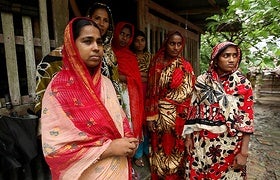This is the sixth and last in a series of posts about the recent report, Bangladesh: Towards Accelerated, Inclusive and Sustainable Growth. The previous post looked at what sort of policies it will take to achieve the goal of middle income status by 2021.
 Bangladesh, one of Asia’s youngest countries, is poised to exploit the long-awaited “demographic dividend” with a higher share of working-age population. Labor is Bangladesh’s strongest source of comparative advantage, and Bangladesh’s abundant and growing labor force is currently underutilized. Absorbing the growing labor force and utilizing better the existing stock of underemployed people requires expansion of labor-intensive activities. And that means expanding exports, as domestic consumption offers limited opportunities for specializing in labor-intensive production.
Bangladesh, one of Asia’s youngest countries, is poised to exploit the long-awaited “demographic dividend” with a higher share of working-age population. Labor is Bangladesh’s strongest source of comparative advantage, and Bangladesh’s abundant and growing labor force is currently underutilized. Absorbing the growing labor force and utilizing better the existing stock of underemployed people requires expansion of labor-intensive activities. And that means expanding exports, as domestic consumption offers limited opportunities for specializing in labor-intensive production.
What are the potentials for expanding exports? Bangladesh’s competitors are becoming expensive places in which to do business. In the next three to four years, China’s exports of labor-intensive manufactured goods are projected to decline. It will no longer have one-third of the world market in garments, textiles, shoes, furniture, toys, electrical goods, car parts, plastic, and kitchen wares. Capturing just 1% of China’s manufacturing export markets would almost double Bangladesh’s manufactured exports.
The Bangladesh wage is half of India’s, and less than one-third of China’s or Indonesia’s. Cambodia, Pakistan, and Vietnam are other apparel exporters taking advantage of extremely low labor costs. Bangladesh can take advantage of this low-cost edge over its competitors. Bangladesh can become the “next China,” with its labor-intensive manufactured exports growing at double-digit rates per year, if it can break the infrastructure bottleneck and take advantage of its large pool of underemployed labor. A recent World Bank study shows that if Bangladesh can improve its business environment halfway to India’s level, it could increase its trade by about 38%. If Bangladesh fails to act soon, others will take the markets China is vacating.
Export-product and market diversification is crucial to insulate the economy from external shocks, such as the recent global financial turmoil and recession in the United States and European Union economies. Experience from other countries suggests that export diversification is associated with generally strong economic performance. Some progress has been achieved in this regard. In fiscal year 2012, Bangladesh exported products worth $1.2 billion to members of the Organization of Islamic Countries, $720 million to members of the Asian Clearing Union, and $634 million to members of the South Asia Association for Regional Cooperation. Japan continues to be a huge potential market which is so far untapped. Bangladesh can also look to other emerging import markets such as Russia, Canada, the United Arab Emirates, South Korea, and China itself.
A new wave of reforms is needed to raise Bangladesh’s growth path. Deepening and diversifying Bangladesh’s labor-embedded exports can transform the country from a rural, agro-based economy into an urban, manufacturing economy. McKinsey & Company’s interview-based survey of chief purchasing officers in European and U.S. apparel companies in 2011 identified a number of challenges which, if not addressed, could cause Bangladesh to miss the opportunity of attracting garment buyers moving out of China. These include:
- Transport: congested roads, limited inland transport alternatives, absence of a deep-sea port
- Utility supply
- Compliance with labor and social standards
- A productivity gap reflecting skill and technological deficiencies
- Soaring risks and long lead times
- Political instability and corruption
By tackling these obstacles head-on, Bangladesh can seize the moment of opportunity to move into the space that China’s transition will open up.


Join the Conversation